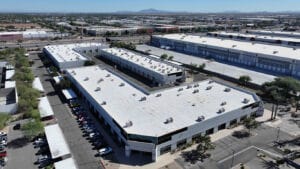Arizona may be lacking many things, but it is certainly ripe with land. There are 9.2 million acres of publicly held land in the Arizona Land Trust and there are plenty of private land owners with parcels available, too. Solar land developers have taken notice.
Since the Solar Investment Tax Credit was extended last year and San Diego announced that it planned to be 100 percent renewable over the next 20 years, solar developers are locking down viable land parcels in Arizona for future solar development.
Arizona State Land Department Commissioner Lisa Atkins says much of the available public land is a good fit for solar development. On the department’s web site, there is even a tool that scores how good a land parcel would be for development, she says. Solar developers picking up public parcels isn’t something new, she adds.
When the alternative energy conversations were just starting to gain traction in the early 2000s, there were many developers who were acquiring large swaths of land to identify where a variety of different sized solar developments could be placed, Atkins says.
Tax incentives
The Solar Investment Tax Credit — which first went into effect in 2006 — helped spur the solar energy industry. In turn, the sale of land that could be used for future solar developments increased.
But developers aren’t just grabbing public land.

In 2009, shortly after the Solar Investment Tax Credit was extended for the first time, Vermaland, one of the largest land owners in the state, saw a large jump in land sales for future solar developments, says Anita Verma, director of marketing at Vermaland.
That initial boost in sales didn’t last. Vermaland saw a lull in land grabs when utility quotas were reached, Verma says. And there was a pesky recession that got in the way.
Arizona’s recovery may have been slower than much of the nation’s, but the outlook has been picking up.
One thing Atkins and the department have noticed are that land purchases for solar developments go along with increases in demand for more energy.
Last year, 91,000 residents moved to Arizona, according to University of Arizona Economic Forecast data released in March. Now that the ITC has been extended once again, the folks at Vermaland are seeing another boost in land sales for solar developments.
“Ever since the (Solar Investment Tax Credit) and a few other things have happened, there has been a huge, sort of rush to come in and tie up land,” Verma says, “and it’s not even necessarily to even develop right now.”
Verma says five deals were completed recently, and there are a few more in the works.
What they want
Atkins says many of the developers going the public land route are much more specific with their solar land purchases. Picking the land for a solar development is a part of an overall business decision, she says, not just thought of in a vacuum.
Verma says developers who are usually building utility-scale projects — anywhere from 50 to 100 megawatts — are looking from land in the 500- to 5,000-acre range.
What developers want most of all, Verma says, is accessible flat land close to the current grid infrastructure.
Proximity to grid infrastructure is especially important because building lines out to a substation or transmission lines can be one of the more pricier parts of the development, she says.
The State Land Department uses 21 weights to determine a land’s solar score on its online parcel viewer. From the department’s experiences, there are a lot of variables that go into a land purchase for solar development, Atkins says.
Finding the right land has been difficult even though there has been an increase in developers looking for land suitable for solar development, says Michelle De Blasi, co-chair of the Arizona Energy Consortium and director at Fennemore Craig.
Tax credits and California
De Blasi has been hearing about recent land grabs in the wake of the Solar Investment Tax Credit extension and Verma cites that as one of the main reasons for these recent land grabs.
Verma says Arizona developers have been also looking into supplying Californians with solar and renewable energy. There are already transmission lines owned by California utilites in Arizona that developers can tap into, she says.
“That’s been a big trend we’re seeing — people coming in and looking to build here and transmit to California,” Verma says.
California wants to have 50 percent of its energy to consist of renewable energy by 2030, and San Diego wants to be 100 percent renewable within 20 years.
De Blasi has been hearing a bit about developers looking to supply California with solar energy, but developers in Arizona who want to send their solar energy still have hurdles to overcome to meet California’s intermittent energy requirements, De Blasi says.
Solar development has been growing in Arizona, and with it are land purchases, especially as solar technology starts to advance. The tax credits don’t hurt either, even as the industry matures.
“The industry itself has been trying to come into line with the rest of the energy industry in terms of not having to have incentives to be cost competitive,” De Blasi says. “It’s come a long way in that realm.”
But those tax credits are still important to investors, she adds.



